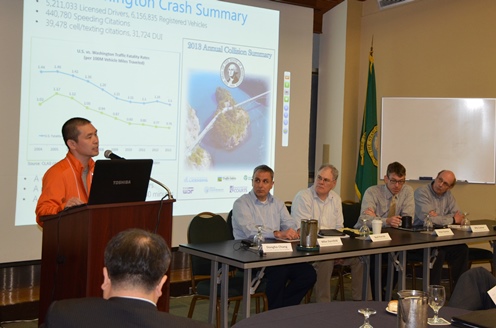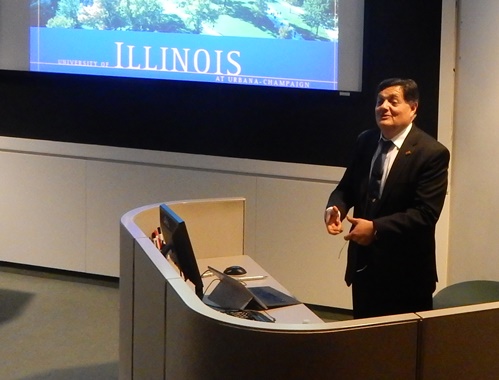PacTrans News
-
May 28, 2015
PacTrans Hosts Region 10 Transportation Safety Workshop
The PacTrans Region 10 Transportation Safety Workshop on May 5 drew representatives from universities, public agencies, and private companies across the Pacific Northwest to discuss important regional transportation safety issues. This workshop was jointly organized by PacTrans, ITE Washington, ITE Oregon, ITE Idaho, and ITE Alaska. Read More
-
April 30, 2015
Imad Al-Qadi Speaks on Uses of Ground Penetrating Radar
Dr. Imad Al-Qadi, an internationally renowned professor in pavement materials and engineering, visited the University of Washington on April 28 to speak at the Spring PacTrans Regional Transportation Seminar. Dr. Al-Qadi, Founder Professor at the University of Illinois at Urbana-Champaign, delivered his talk entitled “Transportation Infrastructure Assessment Techniques Using Ground Penetrating Radar.” (Watch the recorded lecture).
Continuous monitoring of transportation infrastructure allows for the maintenance of durable and safe systems. Ground penetrating radar (GPR) technology, based on electromagnetic waves, is an important non-destructive evaluation method, and yet GPR works better in some situations than in others. Bridge and pavement assessment, primarily for estimating layer thickness and localizing moisture accumulation within structure layers, has successfully used GPR.
However, the “images” obtained from GPR-reflected signals are dependent on the priori unknown dielectric properties of structural materials, which can make GPR data interpretation difficult. It can also prove difficult to detect layer interfaces, but signal and data processing techniques have been developed to estimate the dielectric properties of surveyed structures from GPR reflected signals. These techniques have improved GPR data interpretation and the quality of the GPR signal.
GPR provides quick and reliable information about subsurface characteristics when appropriately used. Pavement layer thickness can be accurately predicted, for example, as well as the location of rebar.
Dr. Al-Qadi has been working on GPR research for more than two decades, among his other diverse research interests. He is the Director of the Advanced Transportation Research and Engineering Laboratory (ATREL) and the founding Director of the Illinois Center for Transportation (ICT). A registered professional engineer, Dr. Al-Qadi has authored/co-authored more than 550 publications and has delivered more than 550 presentations, including numerous keynote lectures.
-
April 23, 2015
Tuesday, 4/28: Dr. Imad Al-Qadi, PacTrans Transportation Seminar
If you are unable to attend in person but would still like to hear the talk, the seminar will be broadcast for live viewing. Watch the seminar online at 9:30 a.m. PST.
Organized by
The Pacific Northwest Transportation Consortium (PacTrans)
USDOT University Transportation Center for Federal Region 10Presentation Title
Transportation Infrastructure Assessment Techniques Using Ground Penetrating Radar
Abstract
The continuous monitoring of transportation infrastructure is necessary to maintain a durable and safe system. Many noninvasive techniques have been used including instrumentation, acoustic emission, infrared, and electromagnetic waves. Ground penetrating radar (GPR) technology based on electromagnetic waves has been used to assess the performance of transportation facilities for the past three decades. After all this time, the main question remains: “How well does GPR work and under what conditions?” Results show that while GPR works well for some situations, it is not appropriate for others. GPR has been successfully used for bridge and pavement assessment, primarily for estimating layer thickness and localizing moisture accumulation within structure layers. However, GPR data interpretation is often difficult because the “images” obtained from GPR-reflected signals are dependent on the priori unknown dielectric properties of structural materials. In addition, GPR cannot detect layer interfaces unless a significant contrast in the dielectric constants exists between the two considered materials. GPR data analysis can also be cumbersome and unreliable due to the large amount of data collected during the surveys. Various signal and data processing techniques have been developed to estimate the dielectric properties of surveyed structures from GPR reflected signals. These processing techniques have been successfully used to enhance the accuracy of GPR data interpretation results and to improve the quality of the GPR signal. Among his diverse research interests, Dr. Al-Qadi has been working on GPR research for more than two decades. He is currently working on utilizing GPR data to predict in-situ real-time asphaltic material density. Dr. Al-Qadi will discuss the recently developed techniques and their field application for quality control/quality assurance, predicting the layer thicknesses of pavement systems, detecting flaws, and predicting density of asphalt concrete.
Speaker
Professor Imad Al-Qadi is the Founder Professor of Engineering at the University of Illinois at Urbana-Champaign. He is also the Director of the Advanced Transportation Research and Engineering Laboratory (ATREL) and the founding Director of the Illinois Center for Transportation (ICT). Prior to that, he was the Charles E. Via, Jr. Professor at Virginia Tech. A registered professional engineer, Professor Al-Qadi has authored/co-authored more than 550 publications and has delivered more than 550 presentations including numerous keynote lectures. He has led more than 100 projects to completion. In addition, he is managing more than 60 projects annually as an ICT director since 2006. He is the past president of the ASCE T&DI Board of Governors and the Editor-in-Chief of the International Journal of Pavement Engineering. Professor Al-Qadi has received numerous prestigious national and international honors and awards including the NSF Young Investigator Award, the quadrennial IGS Award, the ASCE James Laurel Prize, the ARTBA Steinberg Award, the ASCE Turner Award, and the French Limoges Medal. He is a Chapter Honorary Member of Chi Epsilon at the University of Illinois, an Honorary Member of the Societa Italiana Infrastructure Viarie, Emeritus Member of TRB Committee AHD25 on Sealants and Fillers for Joints and Cracks, and an Honorary Professor at Southeast University in Nanjing, China, and KTH Royal Institute of Technology in Stockholm, Sweden. In 2010 he was elected as an ASCE Distinguished Member, the highest honor by ASCE, for his exemplary leadership and innovation in the civil engineering profession. Dr. Al-Qadi holds a B.S. degree from Yarmouk University and M.Eng. and Ph.D. degrees from Penn State University, all in civil engineering. His expertise are on highway and airfield pavement mechanics, tire loading, fracture, and interface, GPR, asphalt rheology, pavement sustainability, and forensic engineering and arbitration.
For questions, please contact Maria Bayya, assistant director for PacTrans, at pactrans@uw.edu or (206) 685‐6648.
-
April 21, 2015
PacTrans Student Leadership Training: Marsha Anderson Bomar and the Language of Leadership
Marsha Anderson Bomar is a transportation entrepreneur, leader, and trailblazer for women in transportation engineering with a list of awards and recognitions that rivals the length of a term paper. To get to where she is today, Anderson Bomar recognizes the importance of developing strong communication skills for career and leadership success. For the PacTrans Student Leadership Training on April 20, Anderson Bomar critically examined the way language can work for and against us, the communication differences between men and women, and what students can do now to build skills to grow as strong leaders.
Of particular focus were the challenges faced by women in light of different communication styles. For instance, Anderson Bomar explained that women “often start off with words that weaken what we say, even if we’re sure.” I think, I believe, I guess all become disclaimers in the way women introduce ideas.
“If the idea is even worthy of being spoken, don’t undermine it,” said Anderson Bomar. She offered a more confident way of posing an idea: “I have an idea I would like to run by you. It may need some refining, but it’s good.”
In addition to gender, generational differences offer an opportunity to bridge the language style divide. Anderson Bomar cited sports as a galvanizing force of the baby boomer generation. By using sports-oriented terms such as “game plan,” one can appeal to and incite action in this age group, particularly with men.
Anderson Bomar also offered suggestions for how students can prepare for leadership now, including practicing public speaking. Also, when the opportunity for volunteering to participate on a project arises, say yes. Eventually, volunteer to lead a project and in the process, Anderson Bomar explained, students will simultaneously learn and build confidence.
-
April 15, 2015
PacTrans Newsletter – Issue #11 Now Available!
Read the April 2015 PacTrans newsletter here.





